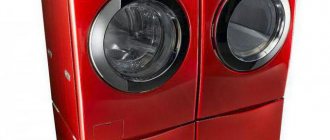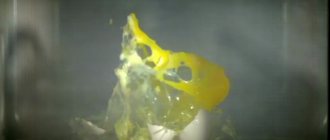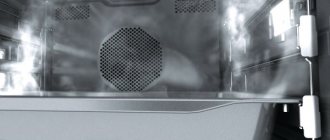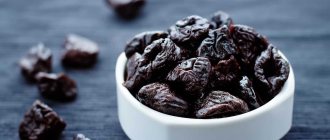Convection in Latin means “transfer.” In this case, it is the exchange of hot and cold air in the oven. In other words, the hot air flow rises to the top, and the cold air flows down. After some time, the temperature throughout the oven becomes the same.
In almost all old ovens, convection was “natural”, that is, heat exchange occurred, but it took a very long time. Housewives had to pull out a sheet of food and turn it over so that the dish would bake evenly. With meat dishes, such manipulations took place without consequences, but baking a high-quality sponge cake or meringue was almost impossible. Now, many ovens have “forced” convection; baking anything has become much more convenient, since the air is distributed evenly.
Principle of operation
Convection in the oven is carried out thanks to a fan installed in it. Its usual location is the back of the oven wall, from where it disperses the air inside. Its task is to achieve the required temperature. After the task is completed, the fan turns off.
Convection can be used in both electric and gas ovens. The advantages of gas ones are that they consume much less electricity. The main heating is carried out from below, so convection in such models is extremely necessary.
First impressions
The appearance of the Candy oven is fashionable: stainless steel finish, clean lines, wide geometric handle, large display, recessed switches, double-layer glass on the door.
The sharp corners on the handle were a little alarming: while cooking, sometimes you rush around the kitchen and you can get caught on a corner. So far, however, he has managed without bruises on his legs, so maybe these are empty fears.
Designation of convection modes
You can usually see the oven modes on the control panel. Convection itself is indicated by a fan icon, and there may also be additional functions. Eg:
- A horizontal line below the fan means bottom airflow
- Top line - top blowing
- Bottom and top line - simultaneous top and bottom blowing
- With a zigzag on top means airflow and grill mode
- Fan icon with "Eco" label listed as humid convection
Steam
Water needs to be poured directly onto the bottom of the oven , there is a recess there, but it is small, and if the oven is not very level, then the water simply spills over the entire surface.
The instructions limit the volume of water - 300 ml; adding water during cooking is not recommended.
Therefore, it is important to turn on the steam function already when the oven has heated up to the set temperature . This somewhat limits cooking when programming time: steam is turned on automatically when the mode is turned on, and the water will begin to evaporate faster.
Of course, such a small volume of steam does not allow it to be fully used, especially if the dish is cooked for longer than 40 minutes. But it plays its role, as I was convinced of while cooking.
Wet convection mode
An oven with this mode is simply a real find for those who are in favor of proper nutrition. After all, in this mode you can prepare many different delicious and dietary dishes. The principle of its operation is that dishes are prepared by being evenly blown from all sides with moist hot steam. This affects cooking time and food quality. Steam is created due to the fact that such ovens have special built-in containers into which clean water is poured. As a result, the dishes are tasty, juicy, not overdried, and most importantly, all vitamins are retained.
Oven heating modes
General information.
Heating modes.
General information.
Built-in electric ovens can be static and multifunctional .
Any electric oven has heaters
— Heating elements, due to the heating of which food is cooked.
Bottom heater
usually hidden under a metal sheet and not visible to the eye, but the upper heating element and grill are located under the ceiling of the oven, you can look at them and touch them with your hands. They are not hidden under a metal sheet, because... infrared radiation does not pass through metal.
Top heaters
- the thing is quite interesting.
Firstly, there is a heating element that runs along the perimeter of the oven ceiling and is called the upper heating element. Secondly, it is a curved heating element located in the middle - a grill , which looks similar to the heating element of a kettle or an automatic washing machine.
At maximum temperature (usually 220-250°C), the grill becomes red hot. In this case, the surface of the dish located on the middle part of the grill, placed on the upper or middle level, is heated directly. Ovens with two heating elements and a grill are called static
.
But such technology cannot be called modern. This is yesterday’s, or maybe the day before yesterday’s, level of comfort. Static ovens have been confidently replaced by appliances that are rightly called multifunctional or multifunctional
.
What changed? The upper and lower heating elements remained in their places, but a small but fast fan appeared on the back wall of the oven, which circulates air throughout the entire interior of the oven, providing faster heating and even distribution of hot air. And in many models of MIDEA ovens there is also a ring heater located on the back wall, around this fan.
By simultaneously operating the bottom heater with a fan or two heating elements with a fan, the time required to prepare any dish is reduced. In addition, as mentioned above, the cooking temperature in this mode can be reduced by 20-30°C, which is recommended in some instructions.
The number of heating modes also depends on the number of heating elements. MIDEA ovens can have from 2 to 4 heaters. Accordingly, the number of heating modes varies from 3 to 8.
Interesting detail. Most manufacturers artificially increase the number of modes, including the lighting mode. Thus, upon careful examination, in cabinets with declared 8 or 9 modes, in fact there are only 7 or 8 of them. After all, the function of lighting the inside of the oven cannot be called a heating mode. MIDEA does not resort to such a trick and honestly names exactly the number of heating rekhims.
Designations and brief description of heating modes.
Top heating.
The mode is selected for frying almost finished dishes on top, such as cakes, casseroles, browning breading, and also for cooking lightly fried vegetables on the grill.
Bottom heating.
This mode is ideal for individual large dishes such as cake. The best result is achieved if you place the dish in the center of the oven. Selecting this mode is recommended for long-term cooking.
Grill.
This solution allows you to use the oven as a home grill. It is used for quick baking and frying of kebabs, bacon, chops, sausages and steaks, as well as bread toasts and fish.
Double grill.
In this mode, the two upper heaters are activated. High power allows you to significantly reduce cooking time, and also allows you to grill larger portions of meat.
Top and bottom heating.
Traditional heating method. It allows you to prepare cakes and other dishes according to many recipes. This setting allows you to bake a variety of foods, from bread and cakes to baked venison.
Convection.
The formation of hot air by the heating element around the fan and its uniform distribution throughout the chamber. Firstly, in the hot air circulation mode, you can bake pies and pastries at the same time on several oven levels. Secondly, there is no need to preheat the oven for baking times longer than 20 minutes. Thirdly, this mode can be used for defrosting dishes and baking yeast dough. Fourthly, circulating hot air saves energy and time, and also helps keep the oven clean.
Double grill with fan.
The ideal way to roast large, juicy pieces of meat. Allows you to fry them evenly on the inside, and at the same time create a crispy crust on the outside. This method also allows you to cook delicious meat without having to turn it over.
Top and bottom heating with fan.
Thanks to more uniform heating, 30-40% energy savings are achieved. The dishes are lightly baked on the outside and well cooked on the inside. This mode is ideal for frying large pieces of meat at high temperatures.
Defrosting.
Circulating air at room temperature allows frozen food to defrost faster without using heat. This is a gentle way to speed up the defrosting time for delicate foods, as well as fish and poultry.
Lighting.
Not a heating mode. Used for convenience when manually cleaning the oven.
On our website you can choose an oven with various parameters according to your needs.
For the availability of modes, read the detailed description for each model in the Product Catalog on the Ovens tab. If you have any questions or suggestions about MIDEA ovens, please ask them on our blog, on the page dedicated to Ovens. or by email This email address is being protected from spambots. You must have JavaScript enabled to view it.
Advantages of convection ovens
Undoubtedly, ovens with a similar mode have a lot of advantages. In such cabinets you can prepare many different dishes, and even use them as a sterilizer.
Pros:
- Even distribution of air throughout the oven
- Ability to cook several dishes at once
- Minimum gas and electricity consumption
- Additional modes such as drying, defrosting
This mode can be used for drying fruits, nuts, meat, and crackers. You can also use it to defrost food. If you turn on the convection 15 minutes before the dish is ready, it will be covered with a golden crust.
Mechanical control panel
Conventional rotary knobs are most often found on inexpensive ovens with a small number of modes, as well as on gas models, since they do not have rich functionality. The number of icons here is usually small and it will be easier to understand them. The easiest way to navigate is with the indicators of a timer or thermostat, around which the manufacturer has simply prescribed the heating temperature. You will have to get acquainted with other icons.
The most popular designations:
- “Light” – turns on the lighting in the oven for visual control of food preparation.
- “Snowflake” or “Snowflake with drops” – defrosting food.
- A horizontal line at the top of the pictogram, at the bottom, or simultaneously in two parts of the square - respectively, heating by the upper, lower heating element, or both at once.
- If the lines are dotted, this is a low-temperature or gentle cooking mode at +70..+120 °C.
- The fan symbol indicates convection mode, that is, blowing hot air into the chamber. As a rule, it is supplemented by the position line of the working heating element.
- The wavy line or teeth symbolize the grill. An additional horizontal stripe above the icon is the fast grilling mode, and the convection icon corresponds to the turbo grill program.
- Double-sided horizontal arrow with a pair of arms – skewer.
When using convection in the oven, it is recommended to choose a heating temperature 20-40 °C lower than in the case of conventional modes.
Sometimes on the oven panels there are simple and recognizable symbols of modes for specific dishes, for example, for baking pizza, bread or pastry. It’s easy to guess the purpose of the selected option, but its characteristics (cooking time and heating temperature) are best clarified in the instructions.
Functional
My children dubbed the month of dough the month of pizza : we used the “Italian” program to the fullest.
We prepared pizzas large and small, on thick bases and on thin wheat flatbreads, using proven recipes and experimenting with different flavors.
Excellent program: the pizza is of the highest quality!
During operation of this mode, convection is intensively used (the fan rotates so that the pizza dish bounces on the grill). Everything is baked evenly, the cheese melts but does not burn. We liked!
And, of course, I actively used steam programs .
Still, when baking fish and when preparing pastries such as strudel, steam is the best assistant. The fish does not dry out and turns out more juicy.
Puff pastry under the influence of steam becomes more airy, and at the same time soft. Those 15-20 minutes of active steam generation are, in principle, enough to saturate the dish, but it’s a pity that you can’t add water, because when baking, for example, a turkey, 300 ml of water for steam is clearly not enough.
I liked cooking in the Candy FCPS815XL : the oven heats up very quickly, heats up evenly, there are a variety of modes , allowing you to cook any type of food . In addition, the oven can be used to rise dough (fan +50 degrees) and to prepare yogurt. I can imagine how many more delicious things we have ahead of us: the plans include “Anna Pavlova”, meat pies, casseroles and moussaka, creme brulee and profiteroles, and, of course, pizza, pizza, pizza.
Care
If you use unfiltered water, whitish marks will remain on the bottom of the oven after cooking . They can be immediately wiped with a damp cloth and are easily removed. Once every few months, you can use a citric acid solution or vinegar for cleaning.
The same steam will help clean the interior of the oven.
The Aquactiva function provides heating for 30 minutes, during which time the steam will soften all dirt on the oven walls and make cleaning easier.
Characteristics
Modes : 8 – defrosting, fan cooking, grill + convection, convection + bottom heating element, traditional (top + bottom), grill, pizza, Aquactiva.
Modes with steam: convection + steam, grill + convection + steam, grill + steam.
Temperature range : from 50 to 275 degrees.
Volume : 70 l.
Class : energy efficiency A.
Controls : recessed rotary temperature and mode switches, steam button, LCD display, clock; protection from children; programming cooking time and end of cooking.
Care : Aquactiva steam cleaning system, easy-to-clean enamel.
Equipment : a pair of telescopic guides, a metal grid, a deep baking tray.
Dimensions : 595x595x568 mm . Niche : 590x560x560 mm.
Warranty : 1 year.
Country of origin : Turkey.
Price : 25990 rub.
Types of convectors
Oven manufacturers are constantly working to improve fans. After all, such a seemingly insignificant detail plays an important role in cooking, speeding up and facilitating the process.
Convection types:
- the heating circuit is used to quickly heat the air;
- hot air generated by the fan heats the cabinet at an accelerated pace, and is an ideal solution for quickly cooking food;
- moist convection will be appreciated by supporters of proper nutrition, connoisseurs of healthy dishes, and food cooked in the “steamer” mode.
Depending on the energy consumed, location and design features, convection ovens are:
- gas and electric;
- free-standing or built-in;
- working autonomously or connected to the hob;
- mini-ovens resembling small microwaves.











